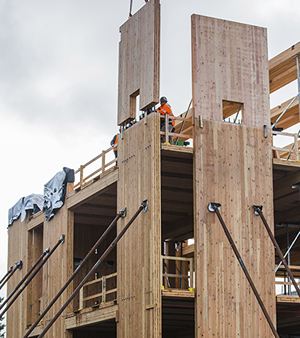
Oregon State University and University of Oregon Team Up to Launch TallWood Design Institute, Advance Mass-Timber Technologies

EDA 2015 Regional Innovation Strategies (RIS) grantee Oregon State University (OSU) has partnered with the University of Oregon (UO) to launch the TallWood Design Institute (TDI), an innovative collaboration that brings together world-class expertise in wood science and technology, forestry, architecture and engineering to carry out applied research and support product development and testing of structural wood building materials and systems.
The results may revolutionize the advanced wood product supply chain and boost Oregon’s forest-dependent rural communities.
In the latest wave of product innovation to hit the wood products industry, a toolkit of new engineered wood products such as cross-laminated-timber has arrived to offer high-performance, sustainable alternatives to more energy-intensive materials like concrete and steel, driving a renaissance in the use of wood in larger non-residential and multi-family buildings. Dubbed “mass timber’, these products combine smaller wood elements into large panels, columns and beams that can be prefabricated using precision computer-controlled equipment, offering quick assembly at the construction site, improved quality, simplified jobsite logistics in addition to reduced waste and noise. Mass timber products require about one-fifth as much energy to produce as steel and one twenty-fourth that of concrete.
It is perhaps not surprising that the first certified manufacturer of cross-laminated-timber is located in Oregon, the nation’s leader in the production of lumber and plywood.
Mass timber offers a dual benefit to those living near the state’s expansive forestlands. As companies invest in mass timber manufacturing capacity – as recently done by DR Johnson, a family-owned lumber company located close to Oregon’s timber heartland of Roseburg – the demand for such innovative products may help bring high-skill jobs to Oregon’s rural communities.
To date, TDI is working with industry, building code officials, designers, engineers and municipal officials to address issues that currently can act as barriers to mass timber projects.
Some examples of the work already carried out include:
- OSU faculty worked with plywood manufacturer Freres Lumber Company to develop and test a brand-new category of mass timber product, now known as the Mass Plywood Panel. Using veneers instead of lumber, the product utilizes a higher proportion of each log and can achieve similar strength values with less mass than cross laminated timber. After working with OSU on two phases of testing, Freres opened a highly-automated $35 million greenfield manufacturing facility in rural Oregon which will create 40-50 new jobs.
- OSU researchers conducted structural and fire tests for elements of a new 12-story mass timber building which will begin construction in downtown Portland this year. The project, named “Framework”, is the winner of the 2015 USDA Tall Wood Design Competition, and will be the tallest wood building in the US.
- OSU and UO research teams are testing asphalt/timber combination systems which will form the driving surface of a mass timber parking structure, to be built by the City of Springfield, Oregon in 2019.
- An OSU engineering team is working with Corvallis nonprofit Cascadia Seismic Strategies to develop and test a mass-timber based seismic retrofit system that can be inexpensively installed in older unreinforced masonry buildings (URMs) without disrupting building occupants. Portland alone has 1,650 URMS that are vulnerable to earthquakes, and the system could have huge public safety impacts as well as representing a previously untapped market opportunity for mass timber producers.
Combined, the diverse activities being carried out through the University of Oregon in partnership with Oregon State University at the TallWood Design Institute are driving product demand, increasing manufacturing capacity and overcoming barriers to the use of mass timber products.
